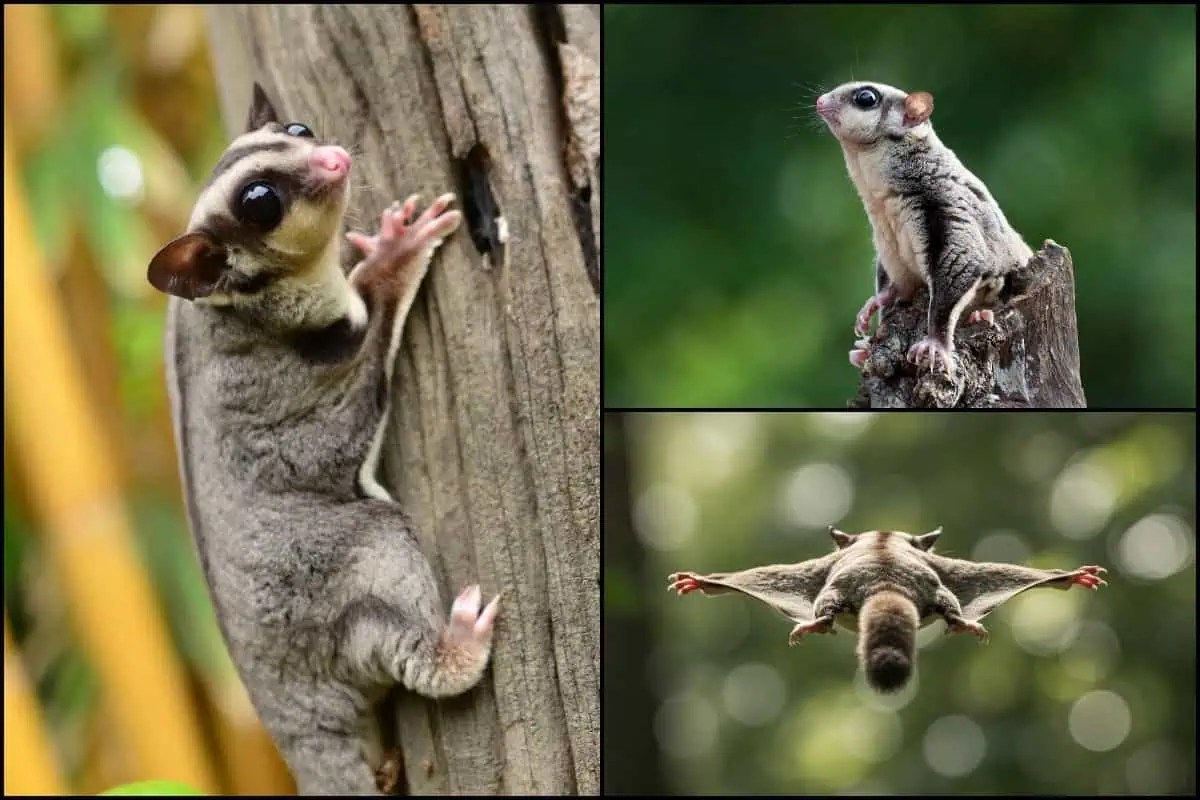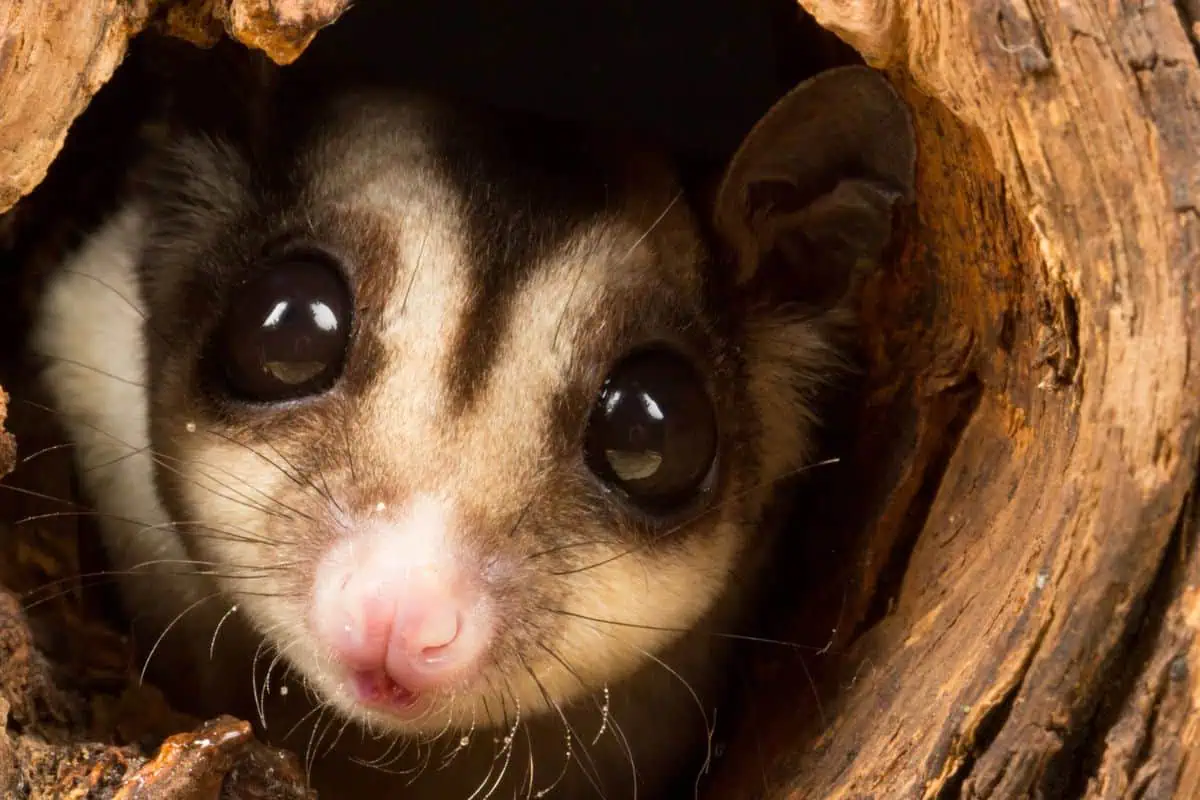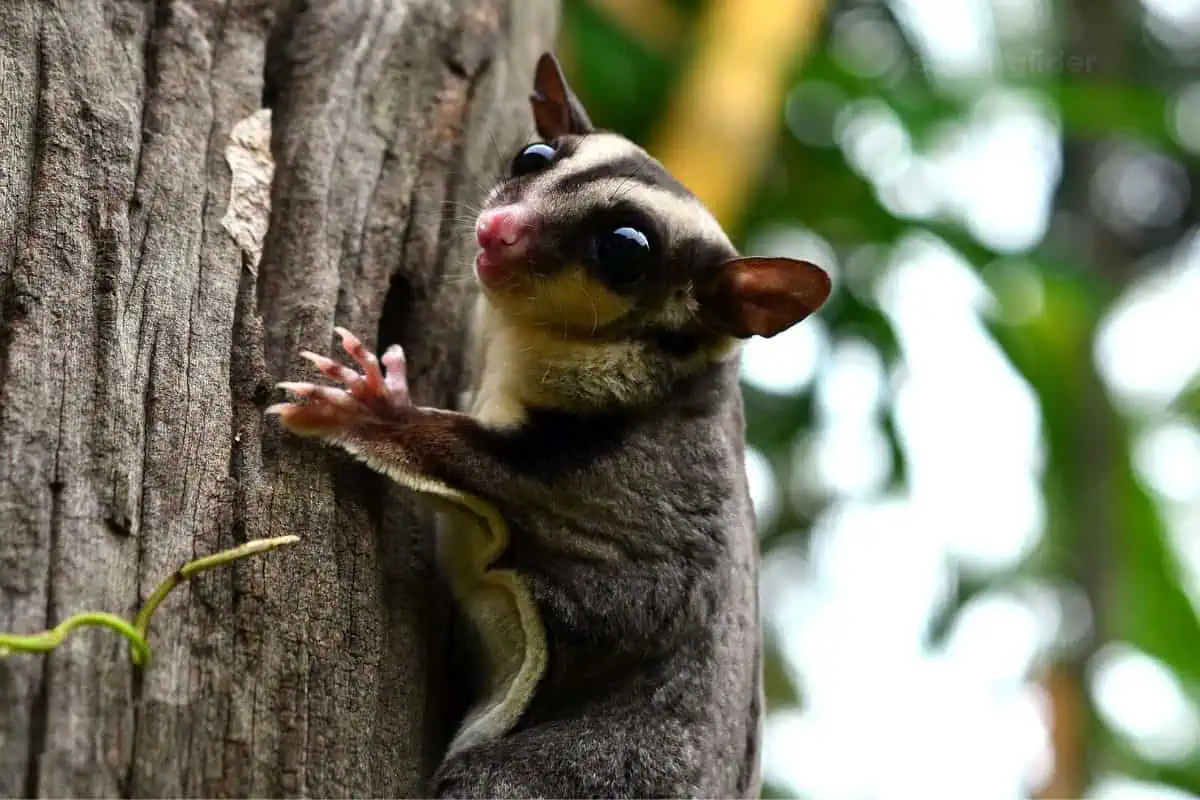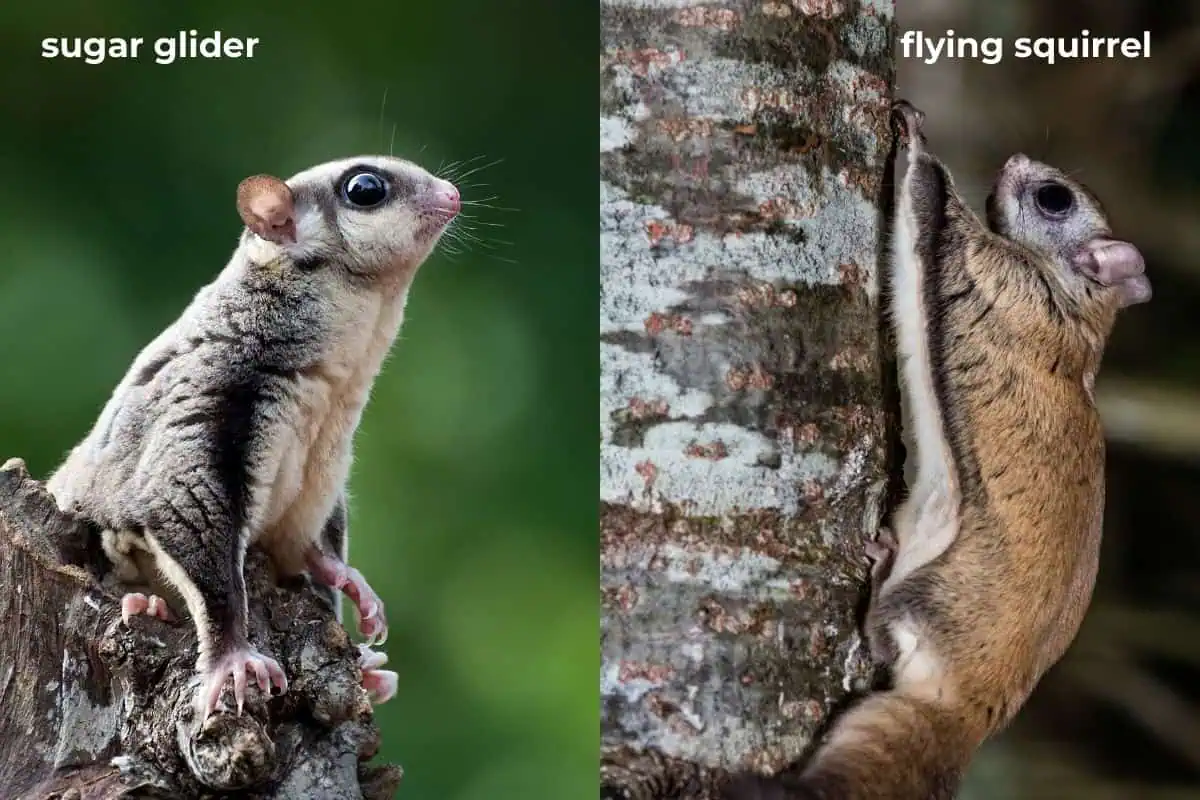Sugar gliders are small nocturnal marsupials that glide between trees, live in tight social groups, and have a surprising number of unique traits that most people never hear about. These facts about sugar gliders cover their anatomy, gliding ability, diet, behavior, and how they compare to better known animals like flying squirrels.
Facts about sugar gliders
1. Sugar gliders are marsupials.
Unlike rodents, sugar gliders are marsupials, which means females carry and nurse their young in a pouch. Their closest relatives are possums from Australia and nearby regions, not squirrels or other rodents, even though they share some similar habits like climbing and gliding.
2. They are native to Australia, Tasmania, and New Guinea.
In the wild, sugar gliders live in forested areas of eastern and northern Australia, the island of Tasmania, New Guinea, and some nearby islands. They are most closely associated with eucalyptus forests and other wooded habitats that provide tall trees and plenty of places to glide.
3. They glide using a membrane called the patagium.
A sugar glider has a loose flap of skin called the patagium that stretches from its wrist to its ankle. When the animal spreads its legs out to the sides, this membrane opens up like a small parachute and allows it to glide from tree to tree instead of climbing down to the ground.
4. They can glide up to about 150 feet.
Under the right conditions, a sugar glider can launch from a tree, open its patagium, and glide for as much as 150 feet before landing. These long glides are a fast and efficient way to move through the forest canopy while staying above the reach of most ground predators.
5. They steer with their tail and limbs.
While in the air, a sugar glider can change direction and adjust its landing by moving its tail and shifting its limbs. Tiny changes in how the patagium is stretched help them bank, turn, and slow down so that they land on trunks and branches with impressive control.
6. They are nocturnal animals.
Sugar gliders are active mainly at night. During the day, they stay hidden in tree hollows or nest boxes to avoid predators and heat. When the sun goes down, they leave these shelters to search for food, glide between trees, and interact with other members of their group.
7. They live in social colonies.
In the wild, sugar gliders rarely live alone. Instead, they form social colonies that often include six to ten individuals that share sleeping sites and defend a common territory. This group lifestyle helps them stay warm, find mates, and protect themselves from predators.
8. They rely on scent marking to recognize each other.
Scent is very important to a sugar glider. Members of a colony mark branches, sleeping areas, and even each other with scent from their glands. This creates a shared group smell that helps them recognize family or colony members and distinguish them from outsiders.
9. They use many different sounds to communicate.
Sugar gliders are quite vocal animals that use barks, chirps, clicks, hisses, and buzzing sounds to communicate. These sounds can signal alarm, contact calls between group members, or mild dispute noises when there is competition over food or space.
10. Their name comes from their love of sweet foods.
The name sugar glider comes from their fondness for sweet foods such as nectar, tree sap, and the sugary secretions of certain plants. In the wild, they often strip bark to lap up sap or visit flowers at night to feed on nectar while also consuming insects for protein.
11. Insects make up an important part of their diet.
Although they are known for eating sweet plant materials, sugar gliders are also active insect hunters. They will catch beetles, moths, and other invertebrates on branches or in the air, especially during warmer months when insects are abundant and offer a rich source of protein.
12. They are very small animals.
Adult sugar gliders typically measure only about 4 to 7 inches from the tip of the nose to the base of the tail. Their body is roughly the size of a small hamster or gerbil, which makes their ability to glide such long distances even more impressive.
13. Their tail helps with balance and control.
A sugar glider has a long, fluffy tail that is about as long as its body. This tail acts as a counterbalance when they climb and leap, and it also plays a role in steering during glides. Some individuals can even use the tail to grip branches or help carry nesting material.
14. They have large eyes for night vision.
One of the first things people notice about sugar gliders is their big dark eyes. These large eyes collect more light than smaller eyes could, which gives them better vision in dim conditions and helps them navigate safely through the forest canopy at night.
15. They have opposable toes for climbing.
The hind feet of a sugar glider have a partially opposable toe that helps it grasp branches, similar to how a thumb improves grip in primates. This adaptation makes it easier for them to cling to bark, move confidently along narrow branches, and launch into glides.
16. Baby sugar gliders are called joeys.
Like other marsupials, sugar gliders give birth to tiny, underdeveloped young called joeys. A joey crawls into the mother’s pouch shortly after birth and attaches to a teat where it continues to develop, safely hidden from the outside world while it grows.
17. Joeys stay in the pouch for about 60 to 70 days.
Once a joey reaches the pouch, it usually remains there for around 60 to 70 days. After this period, it begins to peek out, then ride on the mother’s back, and finally leave the pouch completely while still returning to the nest for warmth and nursing.
18. They can live 10 to 15 years in captivity.
With proper care, sugar gliders can live a decade or more in captivity, sometimes reaching 10 to 15 years of age. This is much longer than many people expect from such a small mammal, which means they represent a long term commitment when kept by humans.
19. They can enter a state called torpor.
Sugar gliders are able to enter torpor, a short term state in which their body temperature and metabolic rate drop. This allows them to conserve energy during cold weather or times when food is scarce, and helps them survive challenging periods in the wild.
20. They prefer certain types of trees.
In their natural habitat, sugar gliders show a preference for eucalyptus, acacia, and similar tree species that produce sap and provide suitable hollows. These trees offer both food sources and safe nesting cavities high above the ground.
21. Males have scent glands on their head and chest.
Adult males have visible scent glands on the top of the head and on the chest that they use for marking. They may rub these glands on branches, nest sites, and other members of the colony, leaving behind a distinctive scent that helps organize social life.
22. They have many natural predators.
In the wild, sugar gliders have to watch out for owls, large snakes, predatory birds such as kookaburras, and some carnivorous mammals or reptiles. Their gliding ability, nocturnal habits, and preference for staying in the canopy are all useful defenses.
23. Gliding helps them avoid predators on the ground.
Instead of climbing down tree trunks and crossing open ground, sugar gliders glide from tree to tree whenever possible. By staying in the canopy, they reduce their chances of encountering ground based predators such as snakes and some mammals.
24. They are often confused with flying squirrels.
Because they are small, nocturnal, and able to glide, sugar gliders are frequently mistaken for flying squirrels. The two animals look similar at a glance, but they belong to completely different groups, and flying squirrels are found naturally in North America and Eurasia, not in Australia. So they are actually very different animals.
25. They huddle together to conserve heat.
On cool nights, sugar gliders often sleep in tight groups inside tree hollows. By pressing their bodies together, they share heat and reduce the amount of energy each individual must spend to stay warm. This group huddling behavior is important for survival in colder conditions.
26. They can store fat at the base of the tail.
During times when food is plentiful, sugar gliders can build up fat reserves at the base of the tail. This extra energy storage helps them get through lean periods when nectar, sap, or insects are harder to find, and the tail may look thicker when reserves are high.
27. They can leap several feet before opening their glide.
Before gliding, a sugar glider often makes a powerful leap away from the trunk or branch. They can jump about 3 to 4 feet outward, then spread their limbs, open the patagium, and turn that leap into a smooth glide from one tree to another.
28. Grooming is an important social behavior.
Members of a sugar glider colony spend time grooming themselves and each other. This grooming removes dirt and parasites from the fur, but it also reinforces social bonds and helps maintain the shared colony scent that identifies them as part of the same group.
29. They get much of their water from food.
In the wild, sugar gliders rarely visit open water sources. Instead, they obtain most of their moisture from sap, nectar, fruit, and insects. This diet based water supply fits well with their tree dwelling lifestyle, since it lets them stay high in the canopy.
30. They avoid the ground when they can.
Although they are able to move on the ground if they must, sugar gliders prefer to stay in the trees. By traveling from tree to tree using jumps and glides, they can cross large areas of forest with minimal time spent on the ground where they are more vulnerable.
Sugar gliders vs flying squirrels

Sugar gliders and flying squirrels can look somewhat similar at first glance. Both are small, soft furred mammals with big eyes and a gliding membrane that lets them travel between trees. This similar body plan is an example of convergent evolution, where unrelated animals develop similar adaptations to solve the same problem, in this case moving efficiently through the forest canopy.
The biggest difference between the two is their classification. Sugar gliders are marsupials that carry their young in a pouch and are native to Australia, Tasmania, and New Guinea. Flying squirrels are rodents, more closely related to other squirrels and chipmunks, and they are found in North America, Europe, and Asia. Sugar gliders give birth to tiny joeys that develop in the pouch, while flying squirrels deliver more fully formed young that develop in nests instead of a pouch.

Their diets and habitats also have some differences. Sugar gliders rely heavily on tree sap, nectar, and insects, especially in eucalyptus and acacia forests. Many flying squirrels eat more seeds, nuts, fungi, and plant material in temperate or boreal forests. Although both animals glide, they evolved this ability independently and belong to very different branches of the mammal family tree.
Frequently asked questions about sugar gliders
Are sugar gliders rodents?
No, sugar gliders are not rodents. They are marsupials, which means they are more closely related to possums and kangaroos than to rats, mice, or squirrels. Their pouch, reproductive system, and overall anatomy clearly place them in the marsupial group rather than the rodent group.
Where do sugar gliders live in the wild?
In the wild, sugar gliders live in forests of eastern and northern Australia, Tasmania, New Guinea, and some nearby islands. They spend most of their lives in trees, sleeping in hollows during the day and gliding between branches at night while they search for sap, nectar, insects, and fruit.
What do sugar gliders eat?
Sugar gliders have an omnivorous diet that includes nectar, tree sap, sweet plant secretions, soft fruits, and a wide variety of insects. The exact diet can change with the seasons and with local food availability. Insects provide important protein, while plant based foods supply energy and moisture.
Do sugar gliders make good pets?
Sugar gliders are popular in the exotic pet trade, but they are not simple or low maintenance pets. They are long lived, highly social, and nocturnal, and they have specialized dietary needs that can be difficult to meet. Anyone considering a sugar glider should research carefully, check local laws, and be prepared for the time, space, and cost involved in keeping a wild species in captivity.
Are sugar gliders endangered?
In many parts of their native range, sugar gliders are not currently considered endangered and can be common in suitable habitats. However, they still face threats from habitat loss, introduced predators, and changes to forest structure. Local populations can decline if forests are cleared or fragmented, so habitat protection is important for their long term survival.
Additional information about sugar gliders
Sugar gliders are a good example of how diverse the marsupial group really is. Many people think of kangaroos and koalas when they hear the word marsupial, but small, gliding species like sugar gliders show how these animals have adapted to many different ecological roles in Australian ecosystems.
Because they are small, social, and active at night, sugar gliders can be difficult to observe in the wild. Researchers often rely on nest box checks, spotlight surveys, or the signs of feeding on trees to learn more about their behavior. Their gliding lifestyle also makes them sensitive to changes in forest structure, since they rely on continuous tree cover to move and find food.
Even though they are often marketed as cute and easy pets, it is important to remember that sugar gliders are wild animals with complex needs. Whether they are living in a eucalyptus forest in Australia or in a carefully designed enclosure under human care, their health depends on suitable diet, social interaction, and room to climb and glide.
WildlifeInformer.com is your #1 source for free information about all types of wildlife and exotic pets. We also share helpful tips and guides on a variety of topics related to animals and nature. Subscribe on YouTube for videos.







